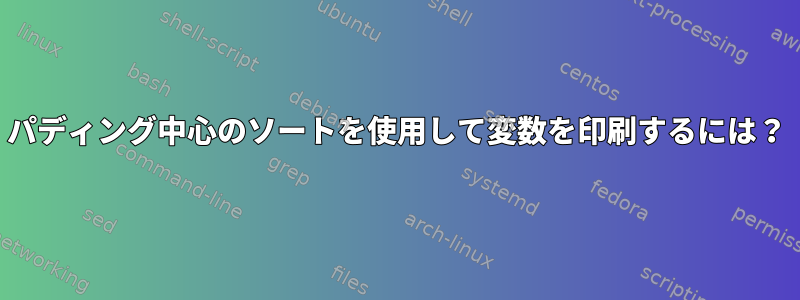
$myvarパディングを端末の中央に、両側が画面の=端にくるように印刷するにはどうすればよいですか?
答え1
私はこの可能な答えを見つけるのに役立つ2つの情報をstackexchangeネットワークで見つけました。
しかし、この答えのコードは私のコードです。
詳細については、編集履歴をご覧ください。ナンセンスと「ステップバイステップ」の両方を削除しました。
最良の方法は次のとおりです。
center() {
termwidth="$(tput cols)"
padding="$(printf '%0.1s' ={1..500})"
printf '%*.*s %s %*.*s\n' 0 "$(((termwidth-2-${#1})/2))" "$padding" "$1" 0 "$(((termwidth-1-${#1})/2))" "$padding"
}
center "Something I want to print"
端子80列出力:
========================== Something I want to print ===========================
パディングは単一文字である必要はなく、単一文字でもかまいません。実際、padding変数はそうではありません。上記のコードでは、長さは500文字です。行のみを変更して他の種類のパディングを使用できますpadding。
padding="$(printf '%0.2s' ^v{1..500})"
結果:
^v^v^v^v^v^v^v^v^v^v^v^v^v Something I want to print ^v^v^v^v^v^v^v^v^v^v^v^v^v^
別の便利な用途は次のとおりです。
clear && center "This is my header"
答え2
そしてzsh:
$ var='some text' |
$ print -r - ${(l[COLUMNS/2][=]r[COLUMNS-COLUMNS/2][=])var} |
===================================some text===================================|
左パッドと右パッドの列数は=端子の半分です。このmフラグを使用すると、幅がゼロまたは幅が2つの文字がある場合は、パディングの文字幅を考慮します$var。
bashGNUを使用すると、wc同じことができます。
var='some text'
width=$(wc -L <<< "$var")
printf -v pad "%$(( (COLUMNS - width) / 2 ))s"
pad=${pad// /=}
printf '%s%.*s\n' "$pad$var$pad" "$(((COLUMNS-width)%2))" =
wc -L私たちはディスプレイの幅を得るためにGNUを使います$var。width=${#var}これは、文字列に単一の幅文字しか含まれていない場合に機能します。
いずれにせよ、$varこれらの仮定には制御文字(TAB、NL、CR、カラーエスケープシーケンスなどを含む)は含まれません。
答え3
この提案は実用的に見えますが、端末がterminfo関数、、、、およびcolscfをサポートしていることを意味します。hpaechcufcud1出力(1)、用語情報(5)、情報CMP(1m)。
#!/bin/bash
# Function "center_text": center the text with a surrounding border
# first argument: text to center
# second argument: glyph which forms the border
# third argument: width of the padding
center_text()
{
local terminal_width=$(tput cols) # query the Terminfo database: number of columns
local text="${1:?}" # text to center
local glyph="${2:-=}" # glyph to compose the border
local padding="${3:-2}" # spacing around the text
local border= # shape of the border
local text_width=${#text}
# the border is as wide as the screen
for ((i=0; i<terminal_width; i++))
do
border+="${glyph}"
done
printf "$border"
# width of the text area (text and spacing)
local area_width=$(( text_width + (padding * 2) ))
# horizontal position of the cursor: column numbering starts at 0
local hpc=$(( (terminal_width - area_width) / 2 ))
tput hpa $hpc # move the cursor to the beginning of the area
tput ech $area_width # erase the border inside the area without moving the cursor
tput cuf $padding # move the cursor after the spacing (create padding)
printf "$text" # print the text inside the area
tput cud1 # move the cursor on the next line
}
center_text "Something I want to print" "~"
center_text "Something I want to print" "=" 6
次の提案は、@より強力でスケーラブルで明確です。ワイルドカード~の解決策。
#!/bin/bash
# Function "center_text": center the text with a surrounding border
# first argument: text to center
# second argument: glyph which forms the border
# third argument: width of the padding
center_text()
{
local terminal_width=$(tput cols) # query the Terminfo database: number of columns
local text="${1:?}" # text to center
local glyph="${2:-=}" # glyph to compose the border
local padding="${3:-2}" # spacing around the text
local text_width=${#text}
local border_width=$(( (terminal_width - (padding * 2) - text_width) / 2 ))
local border= # shape of the border
# create the border (left side or right side)
for ((i=0; i<border_width; i++))
do
border+="${glyph}"
done
# a side of the border may be longer (e.g. the right border)
if (( ( terminal_width - ( padding * 2 ) - text_width ) % 2 == 0 ))
then
# the left and right borders have the same width
local left_border=$border
local right_border=$left_border
else
# the right border has one more character than the left border
# the text is aligned leftmost
local left_border=$border
local right_border="${border}${glyph}"
fi
# space between the text and borders
local spacing=
for ((i=0; i<$padding; i++))
do
spacing+=" "
done
# displays the text in the center of the screen, surrounded by borders.
printf "${left_border}${spacing}${text}${spacing}${right_border}\n"
}
center_text "Something I want to print" "~"
center_text "Something I want to print" "=" 6
答え4
あなたはこれを行うことができます
WIDTH=$(tput cols)
WIDTHDIVIDED=$(($WIDTH/2)) # Solves "tput cols divided by 2"
clear
tput cup 0 $WIDTHDIVIDED # Puts the start of the PS1 at column 0 and the terminal width divided by two
お役に立てば幸いです。


